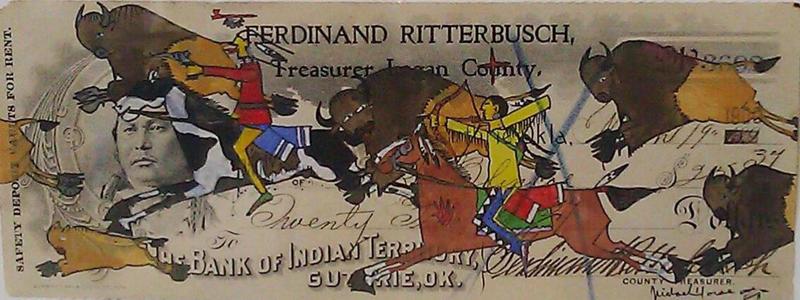Ledger art at the library
February 18th, 2010This article originally appeared on February 18, 2010 in The Island. Michele Ellson, editor.
When artists are denied their tools, they will satisfy the compulsion to create with whatever materials they have on hand. There is a scene in the movie “Quills” in which Geoffrey Rush as the imprisoned Marquis de Sade, denied his parchment, writes his stories on his sheets and clothing. “Ah, you’ve come to read my trousers!” And when his quill and ink are taken from him, he writes with his blood.
When Native Americans were forced onto reservations in the mid-1800s they were prohibited from leaving and denied their weapons, separating them from the buffalo whose hides had been used to create their paintings. And so they turned to the materials on hand to create art and chronicle their lives: paper, in the form of maps and sheets torn from ledgers. This became known as “ledger art.”
Michael Horse, a Bay Area artist, jeweler, and actor of Yaqui, Mescalero Apache and Zuni descent, discovered this art form in the 1970s while working as a cultural consultant with the Heye Foundation in New York and the Southwest Museum in Los Angeles. He decided to continue this tradition – which he describes as a type of “internment art” – using vintage watercolors, pen and ink, and tracking down original documents on which to paint.
Fourteen of Horse’s ledger paintings are on display at the Alameda Free Library through Saturday, February 20. These works exhibit unmistakable irony. One “canvas” is a report by a U.S. Indian Agent in 1876 praising the Native Americans who “… have in all respects shown an ability and aptness in learning that will compare favorably with that of any other class of children….” On this document Horse has painted a Native American man astride a horse, armed only with a ceremonial spear adorned with feathers. He is attempting to speak, but is shot by five rifles wielded by unseen soldiers.
In another piece, the pages of “The Red Man” describe the preservation of Native American culture by outsiders through archeology and study of their language. Yet painted over this are images of Native Americans queued up to have their hair cut short in European fashion. Above each man hovers a symbol representing aspects of their culture which are being lost. Recognizing that their culture can only be preserved through their own efforts, Horse writes in his statement that ledger art recorded “our history from our point of view.”
Supervising Librarian David Hall, staff liaison to the art exhibit committee, said that committee member Ruth Belikove – who is also an associate of the Antique Tribal Art Dealers Association – is very knowledgeable about Native American art, and was the prime person behind bringing this work to the library.
Horse’s ledger paintings are on display in the Regina K. Stafford Room on the first floor of the main library, 1550 Oak Street.
Michael Singman-Aste
Postdiluvian Photo
Tags: Alameda, Alameda Free Library, Michael Horse, The Island




Leave a Reply
You must be logged in to post a comment.